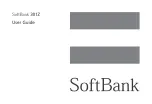
LG-TM250
Neighbor Set
. The set of pilots associated with the CDMA Channel that are probable candidates for handoff.
Normally, the Neighbor Set consists of the pilots associated with CDMA Channel that cover geographical areas
near the mobile station. See also Active Set, Candidate Set, and Remaining Set.
-
A network is a subset of a cellular system, such as an area-wide cellular network, a private group of base
stations, or a group of base stations set up to handle a special requirement. A network can be as small or as
large as needed, as long as it is fully contained within a system. See also System.
Network Identification (NID).
A number that uniquely identifies a network within a cellular system. See also
System Identification.
NID.
See Network Identification.
Non-Autonomous Registration.
A registration method in which the base station initiates registration. See also
Autonomous Registration.
Non-Slotted Mode.
An operation mode of the mobile station in which the mobile station continuously monitors
the Paging Channel when in the Mobile Station Idle State.
Ns.
Nanosecond.
NULL
. Not having any value.
Null Traffic Channel Data
. One or more frames of 16 ‘1’s followed by eight ‘0’s sent at the 1200bps rate. Null
Traffic Channel data is sent when no service option is active and no signaling message is being sent. Null
Traffic Channel data serves to maintain the connectivity between the mobile station and the base station.
Number Assignment Module (NAM).
A set of MIN-related parameters stored in the mobile station.
Numeric Information.
Numeric information consists of parameters that appear as numeric fields in message
exchanged by the base station and the mobile station and information used to describe the operation of the
mobile station.
OLC.
See Overload Class (CDMA) or Overload Control (analog).
Optional Field
. A field defined within a message structure that is optionally to the message recipient.
Order.
A type of message that contains control codes for either the mobile station or the base station.
Ordered Registration.
A registration method in which the base station orders the mobile station to send
registration related parameters.
Overhead Message.
A message sent by the base station on the Paging Channel to communicate
base-station-specific and system-wide information to mobile station.
Overload Class.
The means used to control system access by mobile stations, typically in emergency or other
overload conditions. Mobile station are assigned one (or more) of sixteen overload classed, Access to the
CDMA system can then be controlled on a per class basis by persistence values transmitted by the base station.
Overload Control (OLC).
A means reverse analog control channel accesses by mobile stations. Mobile station
are assigned one(or more) of sixteen control levels. Access is selectively restricted by a base station setting one
or more OLC bits in the Overload Control Global Action Message.
Packet.
The unit of information exchanged between the service option applications of the base station and the
mobile station.
Padding.
A sequence of bits used to fill from the end of a message to the end of a message capsule, typically to
LG Electronics Inc.
- 53 -







































